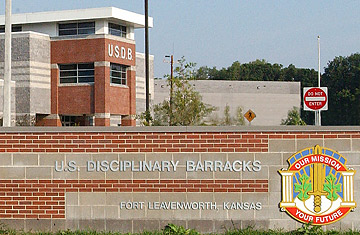
The United States Disciplinary Barracks in Fort Leavenworth, Kan., is one place prisoners might be sent after Guantánamo Bay is shut down
With President Barack Obama having ordered the closure of the Guantánamo Bay military detention facility within a year, the U.S. faces the challenge of finding a new lockup for terrorism suspects currently behind bars and those captured in the future. Reports released by the Pentagon, the Center for American Progress and Human Rights Watch, among others, have recommended several possible sites, most of them in military bases. But moving the Gitmo inmates almost anywhere on U.S. soil would most likely set off a political firestorm.
Pennsylvania Congressman John Murtha, a Democrat, is ready to see the captives moved to his state, saying they would be "no more dangerous in my district than in Guantánamo." His constituents are far from convinced. Some see an economic benefit, because building a maximum-security prison would provide jobs. But others don't want terrorism suspects in their backyard. Diane Gramley, president of the 12,000-member American Family Association of Pennsylvania, has described Murtha's idea as "ludicrous." (See pictures from inside Guantánamo.)
And Murtha is rare among legislators on Capitol Hill in his willingness to have the suspects incarcerated in his district. Most are vociferously opposed to the idea. Possible Gitmo replacement sites include:
1. U.S. Disciplinary Barracks, Fort Leavenworth, Kans.
Fort Leavenworth includes a 515-bed military prison, the only maximum-security prison in the Department of Defense. There are special confinement units in which inmates can be held for up to 23 hours a day. Other security protocols involve chaining prisoners' ankles before they shower; when leaving their cells, inmates are always escorted by two or three staff members. The detention center presently holds 440 major offenders, most of them serving lengthy sentences. There are correctional and treatment programs on-site.
Kansas Governor Kathleen Sebelius, a Democrat, and Senator Sam Brownback, a Republican, have publicly opposed the idea of bringing Gitmo inmates to Leavenworth, which is in close proximity to the surrounding community, including an airport, farms and hospitals. Brownback, terming such a transfer as "unwise and unsafe," has also introduced legislation calling for 90 days' notice prior to transferring enemy combatants to another possible site, in Charleston, S.C.
2. U.S. Naval Consolidated Brig, Charleston, S.C.
A medium-security prison, the brig can hold up to 288 inmates — and has already been used to detain several terrorism suspects, including Jose Padilla and Ali Saleh Kahlah al-Marril. The facility is within walking distance of the Port of Charleston and within two miles of civilian residences. Congressman Henry Brown, a Republican, has said moving Gitmo inmates there would be a "a high-risk move ... I am fearful for what they might bring with them, and I think it would put the local citizens at risk."
3. Camp Pendleton, San Diego, Calif.
As the Marines' largest training facility on the West Coast, the 125,000-acre Pendleton is not lacking for space. But the local Republican Congressman, Representative Duncan D. Hunter, has mounted a fierce campaign against transferring detainees there. "The facilities, as they stand right now, are not designed to house large populations of inmates — they're not prisons," says Hunter's spokesman Joe Kasper. Pendleton has more than 2,600 buildings and structures, along with 7,300 housing units with 14,000 military family members.
Hunter introduced legislation on Thursday to prohibit the transfer of Gitmo inmates to Pendleton or to the nearby Miramar Marine Corps Air Station. "Redirecting these detainees to Camp Pendleton would present a serious threat to surrounding military installations and resources, as well as the community's civilian population," Hunter wrote in a letter to Defense Secretary Robert Gates earlier this month.
4. Miramar Marine Corps Air Station, San Diego, Calif.
The 23-acre Miramar facility can hold up to 400 prisoners and is currently staffed by more than 200 personnel. It is roughly 50 miles from Miramar Air Station, home of the 3rd Marine Aircraft Wing.
Miramar was included in the bill introduced by Congressman Hunter to prohibit transferring Guantánamo detainees to existing facilities or constructing new detention facilities in the same areas.
5. U.S. Penitentiary Administrative Maximum Facility, Florence, Colo.
Called "Supermax" — and sometimes, the Alcatraz of the Rockies — this federal prison 90 minutes outside Denver "houses offenders requiring the tightest controls," according to the Federal Bureau of Prisons. Current inmates include convicted 9/11 conspirator Zacarias Moussaoui, 1993 World Trade Center bomber Ramzi Yousef and self-styled 'Unabomber' Ted Kaczynski.
The 37-acre prison has 490 beds and at present holds 430 prisoners. Like Leavenworth, it has solitary-confinement units enclosed by steel doors. Extreme security is enhanced by motion detectors, cameras, laser beams, attack dogs, 1,400 remote-controlled steel doors and 12-ft.-high razor-wire fences throughout the facility.
6. Metropolitan Correctional Center, New York City
Located in lower Manhattan across the street from the federal courthouse, the high-rise Metropolitan Correctional Center primarily detains pretrial and holdover inmates. These prisoners are held under high security.
